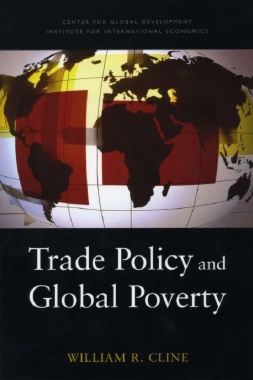The stakes of the poor in trade policy are large: Free trade can help 500 million people escape poverty and inject $200 billion annually into the economies of developing countries, according to author William R. Cline. This book provides a comprehensive analysis of the potential for trade liberalization to spur growth and reduce poverty in developing countries.
It quantifies the impact on global poverty of industrial-country liberalization, as well as liberalization by the developing countries. Half or more of the annual gains from trade would come from the removal of industrial-country protection against developing-country exports. By removing their trade barriers, industrial countries could convey economic benefits to developing countries worth about twice the amount of their annual development assistance. By helping developing countries grow through trade, moreover, industrial countries could lower costs to consumers for imports and realize other economic efficiencies. The study estimates that free trade could reduce the number of people earning less than $2 per day by about 500 million over 15 years. This would cut the world poverty level by 25 percent. Cline judges that the developing countries were right to risk collapse of the Doha Round at the Cancun ministerial meeting in September 2003 by insisting on much deeper liberalization of agriculture than the industrial countries were then willing to offer.
The study calls for a two-track strategy: first, deep multilateral liberalization involving phased but complete elimination of industrial-county protection and deep reduction of protection by at least the middle-income developing countries, albeit on a more gradual schedule; and second, immediate free entry for imports from "high risk" low-income countries (heavily indebted poor countries, least developed countries, and sub-Saharan Africa), coupled with a 10-year tax holiday for direct investment in these countries.
- Cover
- Contents
- Preface
- Acknowledgments
- Summary
- Chapter 1 Sizing Up the Issues
- The Extent and Location of Global Poverty
- Poverty Location by Size Groups
- Table 1.1
- Table 1.2
- Least Developed, Heavily Indebted Poor, and sub-Saharan African Countries
- Table 1.3
- India and China
- Implications
- Trade Patterns in Relation to Poverty
- Table 1.4
- Table 1.5
- Table 1.6
- Poverty, Growth, and Trade
- Does Growth Reduce Poverty?
- The Paradox of Persistent Global Poverty
- Misleading Data?
- Rising Inequality?
- Table 1.7
- Figure 1.1
- Figure 1.2
- Table 1.8
- Population Growth Offset
- The Issue of Convergence
- Does Trade Increase Growth?
- Figure 1.3
- Conclusion
- Appendix 1A Estimating Poverty Rates
- Appendix 1B Poverty Incidence and Elasticity under the Lognormal Distribution
- Appendix 1C Convergence Versus Divergence in International Income Levels
- Chapter 2 Arrangements for Preferential Access: Experience and Potential
- The Generalized System of Preferences
- Special Regimes of the European Union
- Special Regimes of the United States
- Testing for the Trade Impact of Preferential Regimes
- Policy Implications
- Chapter 3 Industrial-Country Protection and the Impact of Trade Liberalization on Global Poverty
- Tariffs on Manufactured Goods
- Peak Tariffs: How Important Are They?
- Tariffs and Quotas in Textiles and Apparel
- Table 3.4
- Table 3.5
- Table 3.6
- Industrial-Country Protection in Agriculture
- Table 3.7
- Table 3.8
- Table 3.9
- Aggregate Protection Against Developing Countries
- The Impact of Industrial-Country Agricultural Trade Liberalization on Global Poverty
- Food Trade Balance and Poverty
- Contingent Protection
- General Equilibrium Model Estimates of Trade Liberalization Effects
- The Poverty Impact of Trade Liberalization
- Protection in Services
- Conclusion
- Appendix 3A Weighting Protection
- Appendix 3B The Tariff Equivalent of Agricultural Subsidies
- Appendix 3C The Impact of Industrial-Country Agricultural Import Liberalization on Poverty Incidence in Developing Countries
- Static Effects
- Figure 3C.1
- Dynamic Effects
- Combined Effects
- Data and Results
- Table 3C.1
- Sensitivity Analysis
- Table 3C.2
- Appendix 3D Trade Balance and Comparative Advantage in Food and Agriculture for Least Developed Countries, 1999–2001
- Chapter 4 Modeling the Impact of Trade Liberalization on Global Poverty
- The Harrison-Rutherford-Tarr CGE Model
- The GTAP5 Trade and Protection Database
- Trade Liberalization Simulation Results
- Table 4.1
- Table 4.2
- Table 4.3
- Table 4.4
- Table 4.5
- Factor Price Effects
- Poverty Effects: Static
- Poverty Effects: Steady State
- Preference Erosion
- Poverty Effects in Alternative Scenarios
- Implications
- Appendix 4A PEHRT Model Definitions
- Chapter 5 The Impact of Trade on Poverty Through Growth Effects
- The Impact of Trade on Growth
- The Impact of Trade Policy on Growth
- The Dynamic Productivity Effects of Trade Liberalization on Global Poverty
- The Combined Static, Dynamic, and Induced-Investment Effects
- Caveats
- Chapter 6 Conclusion
- Principal Findings
- The Doha Round after Cancún
- References
- Index

